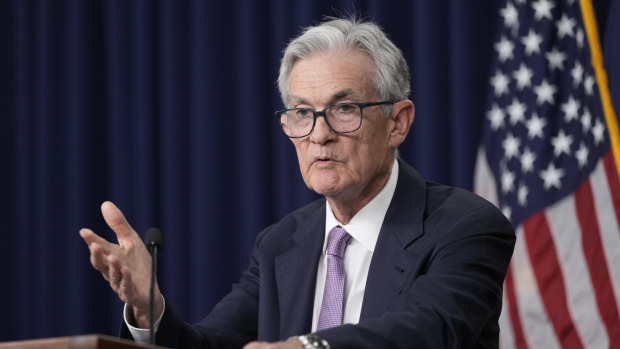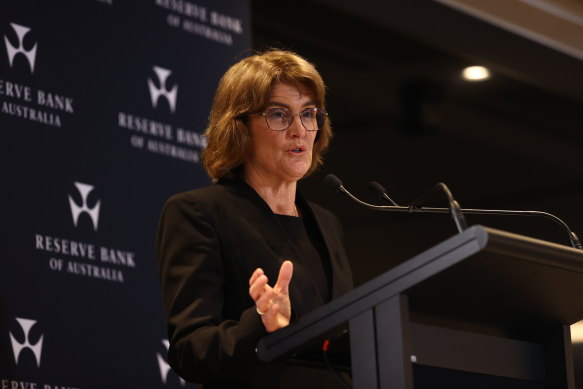US cuts interest rates, turning up heat on RBA
The world’s most important central bank, the US Federal Reserve, has cut its key interest rate by half a percentage point, jolting financial and commodity markets while putting pressure on Australia’s Reserve Bank to bring forward its own plans for rate relief.

After its two-day meeting in Washington, the Fed’s interest rate setting committee decided in an 11-1 vote to bring its key lending rate down to a range between 4.75 and 5 per cent.
Federal Reserve chairman Jerome Powell says the bank has made a “good start” with its half percentage cut in its key lending rate.Credit: AP
Financial markets had been confident of a rate cut, the Fed’s first since the early part of 2020 when it took rates down to zero in a bid to deal with the COVID-19 pandemic. It had started lifting rates in March 2022 before in July last year taking them to their highest level since just before the global financial crisis.
But the half percentage point cut caught markets and many economists by surprise.
Federal Reserve chairman Jerome Powell, in his post-decision press conference, said the bank’s “recalibration” of interest rate settings should ensure strength across both the economy and America’s jobs market.
Loading
More interest rate cuts are likely. The Fed expects a lending rate of about 4.4 per cent by the end of this year and about 3.4 per cent by the end of 2025.
Powell said the half percentage point rate cut gave the bank options as it dealt with changes in the economy.
“We can make a good strong start,” he said.
“We can go quicker if that’s appropriate, we can go slower if that’s appropriate, we can pause if that’s appropriate.”
Reserve Bank governor Michele Bullock has attempted to push back expectations of a near-term rate cut in Australia.
But ahead of the decision, financial markets in Australia put the chance of a rate cut at the RBA’s December meeting at 97 per cent. The same markets have another four cuts priced-in by the end of next year which, if it were to occur, would take official interest rates down to 3.1 per cent.
The larger-than-expected cut by the Federal Reserve had an immediate impact on global currency markets with the US dollar losing value against most major currencies.

The Australian dollar jumped half a cent on the announcement, taking it above US68¢. A stronger Australian dollar will help to push down the prices of imported goods, aiding in the RBA’s efforts to bring down inflation.
But within hours, the dollar had lost its gains while a rally in American share prices immediately after the decision turned around with the S&P 500 and Dow Jones all ending in the red on fears the economy would slower faster than anticipated by the Fed.
Governor of the Reserve Bank of Australia Michele Bullock. Ahead of the Fed decision, financial markets in Australia put the chance of a rate cut at the RBA’s December meeting at 97 per cent.Credit: Dominic Lorrimer
Ahead of the announcement, economists at both Westpac and the Commonwealth Bank said they expect next week’s monthly inflation figures covering August to show a fall in prices. They are forecasting the annual rate of inflation to fall to 2.7 per cent.
Powell said that, while American inflation had fallen substantially, it was still above the Fed’s inflation target of 2 per cent. Australia’s inflation target band is 2-3 per cent.
He said the bank’s “patience”, by not cutting earlier, had also ensured the risks around inflation were now that it may be a little too low rather than remain too high.
“We’ve waited. Other central banks around the world have cut, many of them several times. We’ve waited, and I think that that patience has really paid dividends in the form of our confidence that inflation is moving sustainably under 2 per cent,” he said.
Powell noted that the one piece of the inflation battle that was “dragging a bit” was in housing, with rents not slowing as quickly as expected.
‘We can go quicker if that’s appropriate, we can go slower if that’s appropriate, we can pause if that’s appropriate.’
Federal Reserve chair Jerome PowellSimilar to Australia, Powell said the main issue around housing was the lack of new supply on the market.
“We have had ... not enough housing. So it’s going to be challenging,” he said.
The Fed’s move has political ramifications. Donald Trump, who has signalled a more interventionist approach to America’s central bank, has previously warned the Fed against a pre-election day rate cut.
Loading
Powell said this was the fourth time during his time at a Fed where a rate decision had been made during a presidential election.
He said the election had not even been discussed, noting that countries around the world that had central banks free of government interference had lower rates of inflation.
“It’s a good institutional arrangement that has been for the public,” he said.
The Fed now joins the Bank of Canada and the Bank of England, which meets on Thursday, among the world’s large central banks to start cutting interest rates. The Reserve Bank of New Zealand has also started cutting rates.
The RBA was later than other central banks in starting to lift interest rates which it did in May 2022. Australia’s cash rate, at 4.35 per cent, is still lower than the lending rates in the US, New Zealand and Britain while Canada’s most recent cut took its interest rates down to 4.25 per cent.
Cut through the noise of federal politics with news, views and expert analysis. Subscribers can sign up to our weekly Inside Politics newsletter.
Loading























































